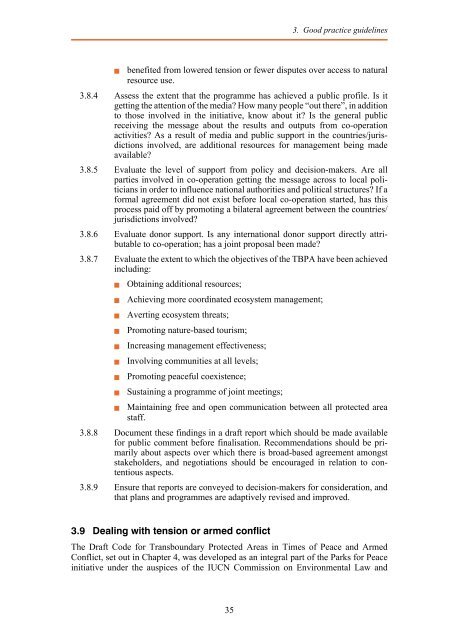Transboundary Protected Areas for Peace and Co-operation - IUCN
Transboundary Protected Areas for Peace and Co-operation - IUCN
Transboundary Protected Areas for Peace and Co-operation - IUCN
You also want an ePaper? Increase the reach of your titles
YUMPU automatically turns print PDFs into web optimized ePapers that Google loves.
3. Good practice guidelines<br />
benefited from lowered tension or fewer disputes over access to natural<br />
resource use.<br />
3.8.4 Assess the extent that the programme has achieved a public profile. Is it<br />
getting the attention of the media? How many people “out there”, in addition<br />
to those involved in the initiative, know about it? Is the general public<br />
receiving the message about the results <strong>and</strong> outputs from co-<strong>operation</strong><br />
activities? As a result of media <strong>and</strong> public support in the countries/jurisdictions<br />
involved, are additional resources <strong>for</strong> management being made<br />
available?<br />
3.8.5 Evaluate the level of support from policy <strong>and</strong> decision-makers. Are all<br />
parties involved in co-<strong>operation</strong> getting the message across to local politicians<br />
in order to influence national authorities <strong>and</strong> political structures? If a<br />
<strong>for</strong>mal agreement did not exist be<strong>for</strong>e local co-<strong>operation</strong> started, has this<br />
process paid off by promoting a bilateral agreement between the countries/<br />
jurisdictions involved?<br />
3.8.6 Evaluate donor support. Is any international donor support directly attributable<br />
to co-<strong>operation</strong>; has a joint proposal been made?<br />
3.8.7 Evaluate the extent to which the objectives of the TBPA have been achieved<br />
including:<br />
<br />
<br />
<br />
<br />
<br />
<br />
<br />
<br />
Obtaining additional resources;<br />
Achieving more coordinated ecosystem management;<br />
Averting ecosystem threats;<br />
Promoting nature-based tourism;<br />
Increasing management effectiveness;<br />
Involving communities at all levels;<br />
Promoting peaceful coexistence;<br />
Sustaining a programme of joint meetings;<br />
Maintaining free <strong>and</strong> open communication between all protected area<br />
staff.<br />
3.8.8 Document these findings in a draft report which should be made available<br />
<strong>for</strong> public comment be<strong>for</strong>e finalisation. Recommendations should be primarily<br />
about aspects over which there is broad-based agreement amongst<br />
stakeholders, <strong>and</strong> negotiations should be encouraged in relation to contentious<br />
aspects.<br />
3.8.9 Ensure that reports are conveyed to decision-makers <strong>for</strong> consideration, <strong>and</strong><br />
that plans <strong>and</strong> programmes are adaptively revised <strong>and</strong> improved.<br />
3.9 Dealing with tension or armed conflict<br />
The Draft <strong>Co</strong>de <strong>for</strong> <strong>Transboundary</strong> <strong>Protected</strong> <strong>Areas</strong> in Times of <strong>Peace</strong> <strong>and</strong> Armed<br />
<strong>Co</strong>nflict, set out in Chapter 4, was developed as an integral part of the Parks <strong>for</strong> <strong>Peace</strong><br />
initiative under the auspices of the <strong>IUCN</strong> <strong>Co</strong>mmission on Environmental Law <strong>and</strong><br />
35

















